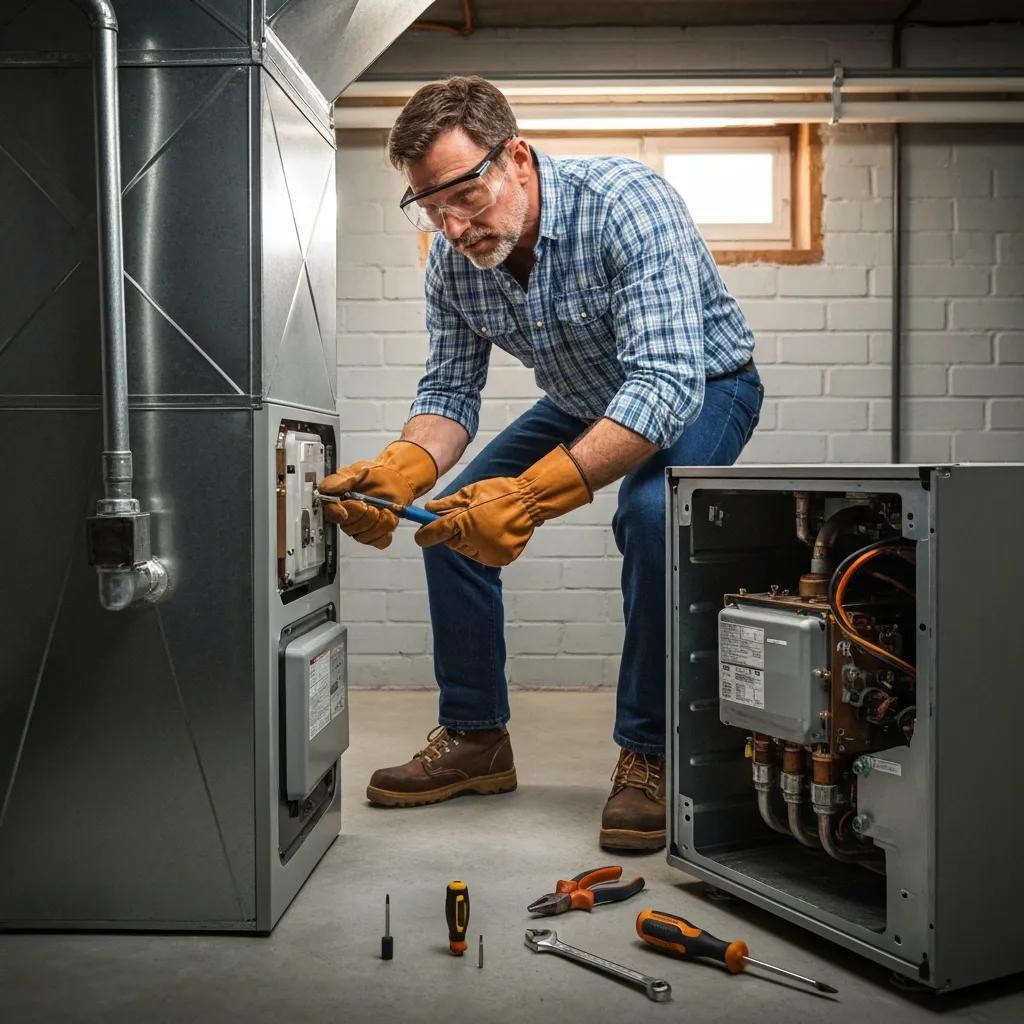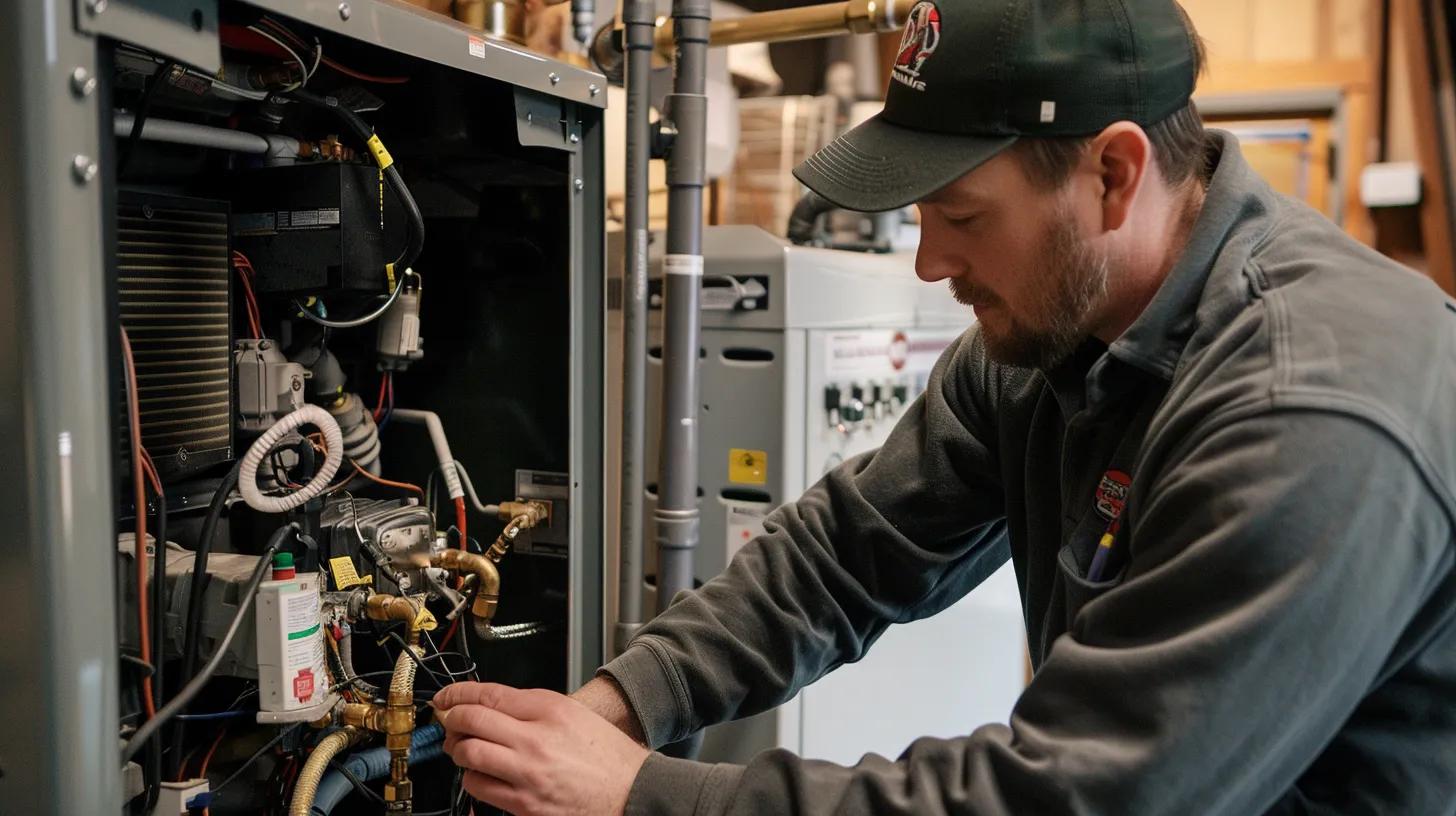Why Isn't My Furnace Heating? Common Causes, Troubleshooting, & Solutions
A furnace that runs but won’t deliver warm air is uncomfortable—and usually points to a problem somewhere in the heating system. This guide explains what “not heating” looks like, the most common mechanical and control causes, and the simple, safe checks a homeowner can try. You’ll learn how to tell the difference between airflow issues, ignition or combustion faults, electrical and control failures, and operational symptoms like short cycling. We’ll also cover which tasks are safe to perform at home and which should be left to a licensed technician. Each section includes practical checklists, quick-reference tables, safety notes, and clear next steps so you can diagnose the issue with confidence and get heat back sooner.
What Are the Most Common Reasons My Furnace Is Not Blowing Hot Air?
When a furnace runs but doesn’t blow hot air, the problem usually falls into one of three groups: restricted airflow, a combustion or ignition failure, or control/electrical issues stopping the burner. A clogged filter can cause the furnace to overheat and trip a limit switch, while a thermostat fault or ignition problem prevents the unit from actually firing. Tripped breakers, blown fuses, or faulty safety switches can also interrupt the heating sequence even though the blower still runs. Sorting the problem into these categories helps you focus quick homeowner checks and narrow down where the issue is before deeper diagnostics are needed. The list below highlights the most frequent causes and simple fixes you can try first.
Common causes and quick homeowner fixes for a furnace not blowing hot air:
- Clogged or dirty air filter: Replace the filter to restore airflow and avoid high-limit shutdowns.
- Thermostat set incorrectly or dead batteries: Make sure the thermostat is on “heat,” check the set temperature, and swap the batteries or reboot the thermostat.
- Ignitor or pilot failure: Watch the ignition sequence; relight a manual pilot if you can do so safely, or call for a technician for electronic ignitors.
- Gas supply or gas valve problem: Confirm other gas appliances work; if you suspect a gas supply issue, stop and call a pro—do not proceed.
- Tripped breaker or safety switch: Reset a tripped breaker and inspect the furnace door switch and any condensate safety switches.
These quick checks separate easy fixes from issues that need professional attention. The table below maps common components, their typical symptoms, and homeowner-level checks for fast reference.
| Component | Common Symptom | Homeowner DIY Check |
|---|---|---|
| Air filter | Restricted airflow, reduced heat | Remove and inspect filter; replace if dirty and confirm correct size/MERV |
| Thermostat | No call for heat | Verify mode and setpoint, replace batteries, reboot smart thermostat |
| Ignitor/Pilot | No flame, delayed ignition, or clicking | Watch the ignition cycle; do not poke or force internal parts |
| Flame sensor | Short cycling or shutdown after ignition | Visual check; light cleaning only if accessible and safe |
| Circuit breaker | No power or intermittent power | Check breaker panel; reset tripped breakers and observe system |
This quick-reference view shows where to focus initial troubleshooting and when to stop DIY work. The next section explains how a dirty filter and thermostat problems affect heating in more detail.
How Does a Dirty Air Filter Affect Furnace Heating?
A dirty filter reduces return airflow, lowering the amount of warm air delivered and making the heat exchanger work harder. Reduced airflow can make the furnace overheat and trip the high-limit switch, which turns off the burner while the blower keeps running—so you’ll feel cold air even though the system seems to be operating. Check the filter by removing it and looking for dust build-up; most homes need a check every 1–3 months depending on pets, occupancy, and indoor air quality. Higher-MERV filters trap more particles but may restrict airflow in some systems, so follow the manufacturer’s recommendations. If filters are consistently clogged or you see heavy duct dust, schedule a technician to evaluate airflow and duct condition.
Why Can a Faulty Thermostat Cause No Heat from My Furnace?
A thermostat that’s in the wrong mode, has dead batteries, or has wiring/calibration issues won’t send a proper call for heat, so the blower may run without the burner firing. Common thermostat problems include incorrect schedules, a fan stuck on “on” instead of “auto,” or a smart thermostat losing connectivity. Basic home checks: confirm the thermostat is on “heat,” set the temperature above room temperature, replace batteries, and reboot any smart thermostat app or device. If the thermostat still behaves oddly after these steps, wiring or an internal relay may be at fault and will need a professional to diagnose safely.
How Can I Troubleshoot Furnace Ignition Problems at Home?

Ignition problems happen when the furnace can’t light or keep a flame—so no heat even though controls and the blower appear to operate. Ignition systems vary: standing pilot, hot-surface ignitor, or electronic spark pilots each fail in different ways. Safe homeowner troubleshooting means observing, doing simple resets, and responding immediately to any gas odor—never attempt repairs on gas valves or sealed combustion parts. Use the step-by-step checks below to decide whether a restart helps or if you need a technician.
Follow these safe, stepwise ignition troubleshooting actions:
- Verify safety first: If you smell gas or detect an unusual odor, leave the home and contact emergency services and a licensed technician—do not relight or run the unit.
- Observe the ignition cycle: Set the thermostat to call for heat and watch for pilot or ignitor behavior—listen for clicking, note delayed ignition, or no glow.
- Reset the system: Turn off the thermostat, switch the furnace power off at the service switch or breaker for 60 seconds, then restore power and try another call for heat.
- Check pilot/light visibility: With a manual pilot, confirm a steady blue flame; with electronic ignitors look for a red glow or listen for ignition clicks that fail to light.
- Inspect accessible items: Ensure the access panel is seated and look for obvious corrosion on visible flame sensor rods—do not disassemble sealed components.
These steps help determine whether an ignitor or flame sensor needs cleaning or replacement. If ignition still fails after safe resets, or if you ever smell gas, stop and call a licensed technician. Air Doctorx Heating & Air Conditioning offers Furnace Service and Repair and Furnace Tune Up—consider scheduling service or a diagnostic visit when ignition problems persist.
What Are the Signs of a Pilot Light or Ignitor Failure?
A pilot that’s out will show no flame; a weak, yellow-orange flame instead of a steady blue flame indicates poor combustion or contamination. Electronic ignitor issues usually show as no glow, delayed ignition, repeated clicking with no flame, or an immediate safety shutdown after a brief flame. You can often verify flame color and stability through the access panel, but don’t touch hot parts. If the flame sensor is sooty or an ignitor looks cracked, call a technician—any smell of gas during ignition means stop and seek professional help right away.
How Do Gas Valve and Flame Sensor Issues Impact Furnace Heating?
The gas valve controls fuel flow to the burners; if it sticks or fails, the furnace won’t light even when the ignition sequence runs. The flame sensor confirms combustion—if it’s dirty or failing, it will shut the gas off after ignition, causing short runs and repeated restarts. Homeowners can sometimes clean a lightly fouled flame sensor if it’s easy to access and the manufacturer permits it, but always power down the unit first. Because gas valves and other combustion parts are safety-critical, persistent gas-flow or flame-detection problems should prompt a professional inspection and repair.
Why Is My Furnace Turning On but Not Producing Heat?
If the furnace powers up—the fan runs or lights blink—but no heat follows, the system has power and some controls are working, yet combustion isn’t happening or heat transfer is impaired. This often results from thermostat mode errors, ignition failures, or airflow restrictions that trigger the limit switch while the blower keeps running. It can also come from control board or relay faults that run the blower independently of the burner. Systematic checks of the thermostat, ignition sequence, and filter condition will show whether this is a homeowner fix or a technician-level electrical/combustion issue.
Quick diagnostic steps to isolate why the blower runs but no heat arrives:
- Confirm thermostat settings: Make sure the thermostat is set to “heat” and the target temperature is higher than the room temperature.
- Check ignition behavior: Watch to see if burners ignite when the thermostat calls for heat—no ignition points to a combustion-side issue.
- Inspect the air filter and vents: Replace clogged filters and ensure return vents are open to prevent high-limit trips.
- Look for error codes: Many furnaces show LED blink codes or panel messages—note patterns for the technician.
If those steps don’t restore heat, the following section explains how short cycling harms performance and typically requires professional diagnosis.
What Causes a Furnace to Blow Cold Air Despite Running?
When a furnace blows cold air while the fan runs, it usually means the blower is operating but the burners aren’t igniting—often due to the thermostat fan set to “on” instead of “auto,” an ignitor/pilot failure, or a blocked filter that caused a safety shutdown. A quick check is to set the thermostat fan to “auto” and raise the set temperature to see if the system attempts ignition. If ignition doesn’t occur, watch for pilot or ignitor activity; if there are ignition attempts but the heat exchanger stays cool, stop running the unit and call a technician. Clarifying these differences prevents wasted troubleshooting and avoids unsafe operation.
When Should I Call a Professional for Furnace Repair or Maintenance?
Certain furnace problems are safety-critical or legally require a licensed technician. Call a professional right away for gas odors, repeated ignition failures after safe resets, visible cracks or corrosion on combustion parts, electrical burning smells, or continuous short cycling that doesn’t stop after filter and thermostat checks.
The following list highlights red flags that require immediate professional intervention:
- Gas smell or suspected leak: Evacuate the home and contact emergency services and a licensed technician immediately.
- Repeated ignition failure or delayed ignition: Risk of unburned gas—stop using the unit and schedule professional service.
- Cracked heat exchanger or visible corrosion: Potential carbon monoxide hazard—do not operate the furnace.
- Electrical burning smells or visible arcing: Power down the furnace and call a technician to prevent fire risk.
- Short cycling that continues after filter and thermostat checks: Indicates deeper control or system faults—request a diagnostic visit.
The table below summarizes which issues are DIY-manageable and which need licensed attention to help you decide when to call a pro.
| Component / Symptom | Problem Severity | Recommended Action |
|---|---|---|
| Gas odor | High | Evacuate and contact emergency services and a licensed technician |
| Cracked heat exchanger | High | Do not operate; schedule immediate professional inspection |
| Repeated ignition failure | Medium-High | Stop operation; schedule diagnostic service with a technician |
| Dirty filter causing short cycling | Medium | Replace filter; if cycling continues, call a technician |
| Tripped breaker from electrical fault | Medium-High | Reset only once; if it re-trips, contact a professional |
This summary clarifies safe homeowner responses versus issues that need licensed intervention. The sections below explain the technician-level repairs and how regular tune-ups prevent failures.
What Furnace Problems Require Expert HVAC Technician Service?
Technician-level repairs include fixing gas leaks, heat exchanger cracks, major electrical faults, gas valve replacements, and sealed-combustion component service—tasks that require special tools, code compliance, and safety procedures. Licensed HVAC technicians use combustion analyzers, pressure tests, and certified methods to restore safe, efficient operation. If your checks reveal gas odors, visible damage, or recurring control faults after safe resets, schedule a professional diagnostic rather than attempting internal repairs. Air Doctorx Heating & Air Conditioning serves Hartly, DE, and the Delaware and Eastern Shore Maryland area and offers Furnace Service and Repair—book a diagnostic visit when expert intervention is needed.
How Can Annual Furnace Tune-Ups Prevent Heating Failures?
Annual tune-ups spot worn parts, clean burners and flame sensors, adjust controls, and verify safe combustion—actions that reduce mid-winter breakdowns and improve efficiency. A typical tune-up covers filter inspection, ignition checks, flame-sensor cleaning, burner and heat-exchanger inspection, blower motor service, and control-sequence testing. Preventive maintenance catches small issues—like an aging ignitor or a miscalibrated thermostat—before they become no-heat emergencies and often extends equipment life. Scheduling a Furnace Tune Up before the heating season is a cost-effective way to avoid emergency repairs and keep your home comfortable.
Frequently Asked Questions
What should I do if my furnace is making strange noises?
Unusual sounds—banging, rattling, or squealing—often signal mechanical issues. Banging can mean loose parts or delayed ignition, rattling may be loose panels or ductwork, and squealing usually points to a worn belt or bearings. Turn off the furnace and check for obvious loose panels or debris. If the noise continues, contact a licensed technician to diagnose and repair the problem before it causes more damage.
How often should I schedule professional furnace maintenance?
We recommend a professional inspection at least once a year, ideally before the heating season. Annual tune-ups identify potential problems, clean critical components, and ensure safe, efficient operation. Regular maintenance can extend the life of your furnace and reduce the chance of unexpected breakdowns—book service in the fall to prepare for winter.
Can I use my furnace if the pilot light is out?
It’s not safe to operate a furnace with the pilot light out. A missing pilot can indicate an ignition or gas supply issue, and attempting to run the system can allow unburned gas to build up. Follow the manufacturer’s relighting instructions if you’re comfortable doing so and see no gas odor. If the pilot won’t stay lit or you smell gas, contact a qualified technician immediately.
What are the signs that my furnace needs to be replaced?
Consider replacement if your furnace has frequent breakdowns, rising energy bills, uneven heating, or is near the end of its expected life (often 15–20 years). Other signs include persistent strange smells, excessive dust, or noises that continue after repairs. If your system requires frequent fixes or can’t maintain comfort, a new, more efficient unit may be the smarter long-term choice.
How can I improve my furnace's energy efficiency?
Simple steps improve efficiency: replace filters regularly, use a programmable or smart thermostat to optimize schedules, seal and insulate ductwork, and schedule annual maintenance. These measures reduce runtime and energy costs while improving comfort. For bigger gains, a technician can assess system sizing and duct performance and recommend upgrades.
Conclusion
Knowing the common reasons a furnace won’t heat helps you act quickly and safely. Simple fixes—like changing a clogged filter or correcting thermostat settings—often restore warmth without a service call. For combustion, gas, or electrical concerns, professional help keeps your family and home safe. If you need assistance, Air Doctorx Heating & Air Conditioning is here to help keep your home warm and comfortable all winter.


